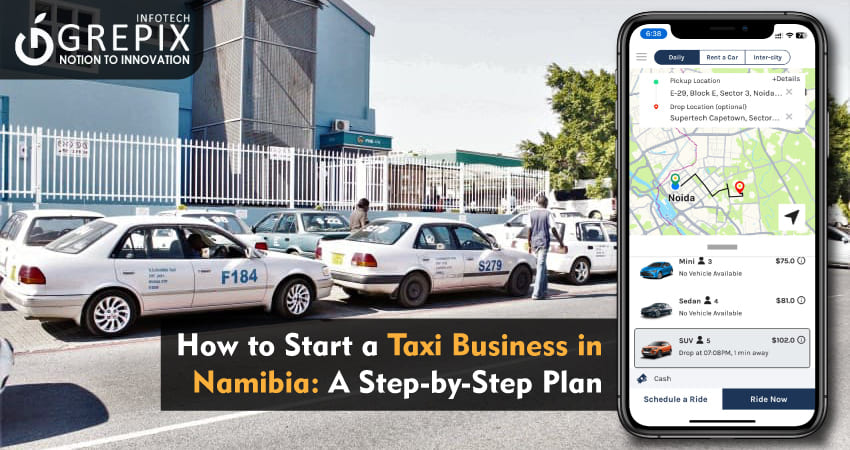How to Start a Taxi Business in Namibia: A Step-by-Step Plan
Starting a taxi business in Namibia is an exciting and rewarding endeavor. With careful planning, a focus on customer service, and a commitment to compliance and safety, you can build a thriving enterprise. The key is to take each step methodically, from understanding the industry to embracing technology and delivering exceptional service.
Now is the time to turn your vision into reality and contribute to Namibia’s vibrant transportation sector.
Launching a taxi business in Namibia offers a promising opportunity to meet the growing transportation needs of locals and tourists alike. With its vast landscapes, urban centers, and vibrant tourist attractions, Namibia has a thriving demand for reliable taxi services. Whether you plan to operate in bustling cities like Windhoek or cater to travelers exploring the countryside, this guide will provide a detailed roadmap to successfully launch your taxi business.
Starting a taxi business in Namibia is a promising venture in a country with growing urban centers and vibrant tourism. With a focus on customer service, safety, and compliance, you can meet the transportation needs of locals and tourists alike. Key steps include understanding the industry landscape, adhering to legal requirements, and developing a solid business plan. Embracing technology, like ride-hailing apps, and delivering exceptional customer service are vital for success. Grepix Infotech, a leader in taxi app development, offers tailored solutions to help entrepreneurs launch efficient, customer-focused businesses. Seize this opportunity to contribute to Namibia's dynamic transportation sector.
1 Understand the Taxi Business Landscape in Namibia
Before diving in, it's essential to grasp the dynamics of the taxi industry in Namibia. There are different types of taxi services, including traditional metered taxis and modern ride-hailing services like Uber or Bolt. Each has its unique market segment and operational model.
For example, metered taxis are popular in urban areas, while ride-hailing apps appeal to tech-savvy customers. Identifying your target audience be it daily commuters, tourists, or corporate clients is the foundation of your business strategy. Conducting market research can help you gauge demand and competition, ensuring your business aligns with customer needs.
2 Research Legal Requirements and Regulations
Operating a taxi business in Namibia requires strict adherence to legal requirements. Start by obtaining a valid driver’s license and ensure all vehicles in your fleet meet roadworthiness standards. You'll also need to register your business and acquire operating permits from local authorities.
Regulations may vary depending on location, so consult Namibia’s Road Transport Directorate for specific guidelines. Staying compliant not only ensures smooth operations but also builds customer trust.
3 Develop a Comprehensive Business Plan
A well-thought-out business plan is crucial for success. Outline your business objectives, target market, and revenue streams. Detail your operating costs, such as vehicle purchases, maintenance, fuel, and employee salaries. Include a marketing strategy that highlights how you'll attract and retain customers.
Your business plan should also address risk management. For example, consider how you'll handle fuel price fluctuations or vehicle breakdowns. With a clear roadmap, you'll be better prepared to face challenges and secure funding.
4 Secure Financing for Your Taxi Business
Starting a taxi business involves significant upfront investment. Depending on the scale of your operations, you'll need funds to purchase vehicles, obtain licenses, and cover initial marketing expenses. Explore financing options, such as bank loans, government grants, or personal savings.
Prepare a detailed financial plan to present to potential investors or lenders. Highlight your projected earnings and how you plan to repay loans. Keeping your finances in check will help you avoid unnecessary debt.
5 Purchase and Customize Your Vehicles
Your choice of vehicles can make or break your taxi business. Opt for reliable, fuel-efficient models that align with your target market. For instance, compact cars are ideal for city commutes, while larger vans may be better for group transport or long-distance travel.
Consider customizing your vehicles with comfortable seating, air conditioning, and GPS systems. These additions enhance the customer experience and set your business apart from competitors.
6 Obtain the Necessary Licenses and Permits
Navigating the licensing and permit process is critical for establishing a legally compliant taxi business in Namibia. Begin by applying for an operator's license, which authorizes your business to offer transport services. You'll also need to register each vehicle in your fleet with the Namibia Traffic Information System (NaTIS).
The application process typically requires proof of vehicle roadworthiness, insurance documents, and your business registration certificate. Ensure you budget for any associated fees and allow sufficient time for processing. Staying up to date with regulations will save you from penalties and interruptions in operations.
7 Implement a Marketing Strategy
To attract customers, you’ll need a solid marketing plan. Start by building a recognizable brand with a memorable name, logo, and slogan. Use local advertising channels, such as radio, newspapers, and community boards, to promote your services. Flyers distributed in busy areas can also work wonders.
In today’s digital age, an online presence is indispensable. Create a website where customers can learn about your services, book rides, or leave reviews. Social media platforms like Facebook and Instagram are excellent for engaging with your audience and running targeted ads. Offering introductory discounts or referral bonuses can help you gain traction in the early stages.
Also Read: "Accelerating Your Fortune: Becoming a Billionaire in South Africa's Taxi Industry"
8 Set Up Operations
Efficient operations are the backbone of a successful taxi business. Begin by establishing a reliable dispatch system to manage bookings and assign rides. You can choose between traditional phone-based dispatching or more modern app-based systems.
Recruit experienced and trustworthy drivers who understand local traffic laws and customer service etiquette. Provide training to ensure they adhere to your company’s standards. Establish explicit guidelines for scheduling, performance reviews, and emergency response.
Properly managing your operations will ensure seamless service delivery and foster customer loyalty.
9 Embrace Technology
Incorporating technology into your taxi business can streamline operations and enhance customer convenience. Consider partnering with or developing a ride-hailing app that allows users to book rides, track drivers, and pay online. This modern approach appeals to tech-savvy customers and reduces manual workload.
Installing GPS devices in your vehicles ensures drivers take efficient routes, saving time and fuel. Digital payment options, such as mobile money and credit card processing, make transactions smoother and more accessible for your customers.
By embracing technology, you’ll position your business as innovative and customer-focused.
10 Focus on Customer Service
Exceptional customer service is what sets successful taxi businesses apart. Start by training your drivers to be courteous, punctual, and knowledgeable about the areas they serve. Clean, well-maintained vehicles also contribute to a positive impression.
Actively seek feedback from customers to identify areas for improvement. Offer loyalty programs, such as discounts for frequent riders, to encourage repeat business. When customers feel valued and respected, they’re more likely to recommend your service to others, boosting your reputation and profits.
11 Ensure Safety and Maintenance
Safety is paramount in the taxi industry. Schedule regular vehicle maintenance checks to ensure your fleet remains roadworthy and reliable. This includes inspecting brakes, tires, and engine performance.
Equip your drivers with training on safe driving practices and emergency protocols. For added security, consider installing dash cameras and panic buttons in your vehicles. These measures protect drivers and passengers, building trust and credibility for your business.
12 Monitor and Adapt Your Business
The taxi industry is dynamic, and staying competitive requires adaptability. Regularly review your business’s performance metrics, such as ride volumes, customer satisfaction scores, and revenue trends. Use this data to identify strengths and address weaknesses.
Stay informed about industry trends and emerging technologies, such as electric vehicles or AI-powered dispatch systems. If you notice a demand for additional services, like airport shuttles or corporate transport, don’t hesitate to expand your offerings.
By continuously refining your operations, you’ll ensure long-term success in the ever-changing market.
Conclusion
Starting a taxi business in Namibia is an exciting opportunity to contribute to the country’s dynamic transportation sector. With its growing urban centers, vibrant tourism, and diverse travel needs, Namibia offers a fertile ground for taxi services that prioritize reliability, convenience, and customer satisfaction.
Grepix Infotech, a leading taxi app development company, is your ideal partner in this journey. We specialize in creating cutting-edge, customizable taxi app solutions that empower entrepreneurs to build efficient and user-friendly businesses. By integrating advanced technology, a robust operational framework, and a customer-centric approach, you can establish a successful taxi enterprise in Namibia.
Whether you are focusing on traditional taxi services or embracing modern ride-hailing apps, our expertise will help you stand out in the competitive market. Together, let’s transform your vision into a thriving business and redefine the transportation landscape in Namibia.
Now is the time to take the first step with Grepix Infotech and turn your entrepreneurial aspirations into reality!
FAQs
1. What are the main challenges in starting a taxi business in Namibia?
Navigating regulatory requirements, managing operational costs, and building a customer base can be challenging. However, thorough planning and adaptability can help overcome these hurdles.
2. How much does it cost to start a taxi business in Namibia?
Startup costs vary depending on factors like the size of your fleet and the type of vehicles you choose. On average, you’ll need funds for vehicle purchases, permits, insurance, and marketing.
3.Can I run a taxi business without owning taxis?
Yes, you can operate as a dispatcher, connecting freelance drivers with customers. This model requires less capital but requires strong organizational skills.
4.What are the best marketing strategies for a taxi business in Namibia?
Use local advertising, social media promotion, and customer incentives like discounts or referral bonuses. A user-friendly website and good reviews also attract customers.
5.How can I ensure my taxi business remains profitable?
Focus on minimizing operational costs, maintaining high service quality, and adapting to customer needs. Regularly review your pricing strategy and explore additional revenue streams.
Looking out to start your own venture like Bolt? Try out our HireMe Taxi Bolt Clone, the easiest way to kick-start your taxi business.








